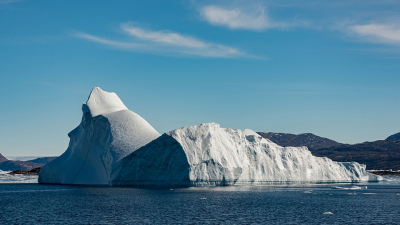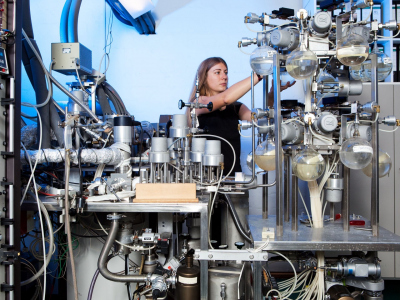- Home
- Discover
- Media Releases
- Media Releases 2018
- Greenland meltwater
Researchers identify Greenland meltwater in the ocean

Over the past 20 years, the melting rate of the Greenland Ice Sheet has almost quadrupled, thus significantly contributing to the global rise in sea level. There are two general causes for the acceleration of glacial-ice melting. Firstly, the atmosphere is warming. The second reason is that the warmer waters of the Gulf Stream are flowing into fiords with glaciers – melting them from below the sea surface. Scientists call the resulting effluent submarine meltwater. This freshwater could then contribute to a weakening of Gulf Stream circulation, which is very relevant to climate development.
Scientists rely on modelling results to study how this additional meltwater influences the Gulf Stream circulation in the North Atlantic Ocean. The rates and directions of meltwater dispersion are vital to these models. This submarine meltwater has now been positively identified in the ocean for the first time.
“Ice contains air bubbles. When glaciers melt, the inert gases helium and neon from the bubbles are dissolved in ocean water and their concentrations are multiplied significantly,” explains Prof. Dr. Monika Rhein of the Institute for Environmental Physics and MARUM – Center for Marine Environmental Sciences at the University of Bremen. Meltwater concentrations of less than one part per thousand can be detected from this signal. The highest concentrations of submarine meltwater – at 0.6 per cent, or six parts per thousand – were identified on the shelf margin near Greenland and Canada. So far, no meltwater has been detected in the central Labrador Sea between Greenland and Canada, the key region of Gulf Stream circulation.
Contact:
Prof. Dr. Monika Rhein
Institut für Umweltphysik, MARUM – Zentrum für Marine Umweltwissenschaften der Universität Bremen
Phone: 0049 421 218 62160
Email: [Bitte aktivieren Sie Javascript]
Homepage
Using state-of-the-art methods and through participation in international projects, MARUM investigates the role of the ocean in the Earth’s system, particularly with respect to global change. It quantifies the interactions between geological and biological processes in the ocean and contributes to the sustainable use of the oceans.

Rhein, M., Steinfeldt, R., Huhn, O. Sültenfuß., J., & Breckenfelder, T. (2018).Greenland submarine melt water observed in the Labrador and Irminger Sea. Geophysical Research Letters, 45. DOI: 10.1029/2018GL079110
Additional information on the function of Gulf Stream circulation


